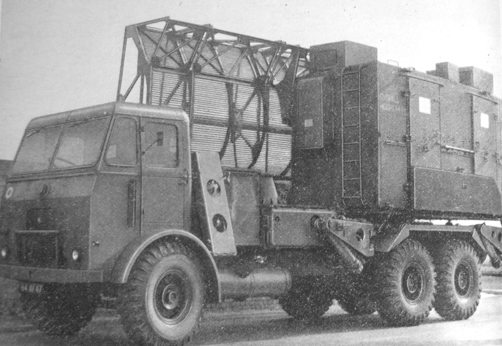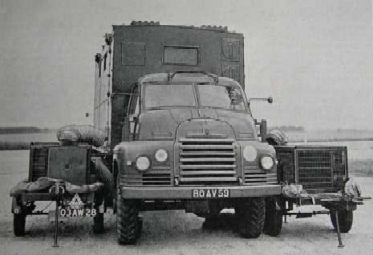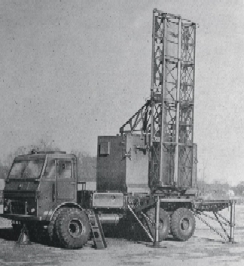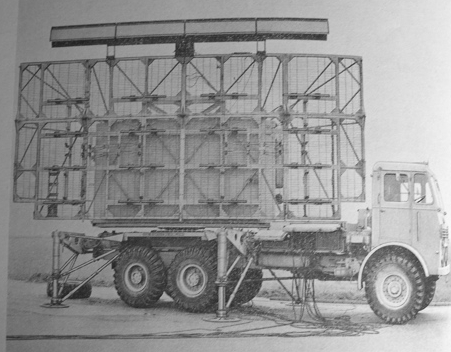- RAF El Adem -
- Setting up Shop -
Whilst we had been slaving at the Bomb Dump our MT people had been unloading the radar gear from the ship and one by one the huge Leyland Hippo lorries arrived  at a site about half a mile from the camp main gates and about a quarter of a mile from the Tobruk road. This site had been checked for mines by Royal Engineers from the Tobruk garrison during the previous week. The four radar heads vehicles were arranged to an established plan in a semi-circle, with the Operations wagon which was almost the size of a small removals pantechnicon, at the centre. Located in close proximity were three diesel generator lorries, cables lorries, a mobile workshop, and a water bowser.
at a site about half a mile from the camp main gates and about a quarter of a mile from the Tobruk road. This site had been checked for mines by Royal Engineers from the Tobruk garrison during the previous week. The four radar heads vehicles were arranged to an established plan in a semi-circle, with the Operations wagon which was almost the size of a small removals pantechnicon, at the centre. Located in close proximity were three diesel generator lorries, cables lorries, a mobile workshop, and a water bowser.
It was strange to find a posse of RAF Regiment with rifles and real bullets sitting in our vehicles when we arrived the following morning. Would the Libyans really have spirited all this gear away in the night but for the armed guard? To make that less possible in the future, several lorries loaded with masses of coiled barbed wire appeared. They were driven slowly around the perimeter of the site while the contents were disgorged like huge stretched springs, snake-like over the tailgate. By the end of the day we were protected in similar fashion to the bomb dump. Attempts made to erect two mess tents were not successful until a pneumatic drill was employed to make holes for the tent pegs: the dusty top layer of desert was only a couple of inches deep, with more or less solid rock underneath. This operation was enlivened by the emergence of a short but lively snake whilst unfurling one of the rolls of canvas. Our knowledgeable MT sergeant declared it to be a Silver Sand Krait and probably a killer, its bite worse than that from a scorpion. It escaped the hue and cry, and the rest of the canvasses were prepared with great trepidation, but only yielded one small scorpion which was crushed on sight.
At last it became the turn of the technical lads to do their stuff. The Consoles people had to get the Operations vehicle ready. This contained several radar displays, a mini vertical plotting table and a section known as the Radar Office which consisted of a couple of racks of electronic equipment which generally drove and synchronised all the rest of the kit. The necessary air conditioning for this van was supplied by a pair of small two-wheeled trailers which produced chilled air and extracted moisture, each being driven by its own small engine. The Operations Room was usually endured by about six people and they did not welcome extra bodies.

Exploded View of an Ops.Wagon similar to this one.(Use'Back' to return)
Meanwhile the Heads people were readying the transmitters. We had two Type 13 nodding height finders, a Type 14 centrimetric search radar and a Type 15 metric search radar. Each unit was mounted on the bed of its Hippo lorry but needed a much more stable platform before it could be allowed to rotate. This was achieved by swinging out and clamping four huge articulated legs each fitted with an 'elephant's foot'.  Hydraulic power provided by the lorry's engine allowed each foot to be lowered independently until the chassis of the lorry was lifted from the ground and suspended beneath the levelled radar, with the huge tyres just off the ground. The lorry cab was then unbolted and hinged forward below the level of the radar cabin. In this ingenious manner the weight of the then superfluous lorry performed a useful function by giving the required stability. The erected radar looked for all the world like some gigantic prehistoric insect.
Hydraulic power provided by the lorry's engine allowed each foot to be lowered independently until the chassis of the lorry was lifted from the ground and suspended beneath the levelled radar, with the huge tyres just off the ground. The lorry cab was then unbolted and hinged forward below the level of the radar cabin. In this ingenious manner the weight of the then superfluous lorry performed a useful function by giving the required stability. The erected radar looked for all the world like some gigantic prehistoric insect.
Over the next couple of days each head was set up and connected by several thick cables to the Ops.Waggon and the 20 kVA generator waggons. This was accomplished by using the Cables lorry which contained many large spools of neatly coiled wires labelled to show where each end should be connected. All the outer ends were plugged into the Ops.Room or to the generators. This done, the lorry was driven gently towards a head and the cables, with only a little manual assistance, unrolled themselves to form long black snakes across the sand behind us. The process was repeated for each head in turn and by mid-morning of the second day the Aged W.O. ticked the last box of his installation schedule, waved his clip-board in triumph and informed us that everything should be ready to be powered-up.
One by one each Lister diesel driven alternator set spluttered into life and then settled to its steady 1000rpm beat. The Ops.Waggon then powered up and after a while the Consoles people announced that they were ready.
 In the cabin of the Type 15 (shown above) I started the Control Unit and to my great relief it went through its lengthy multistaged sequence of switching in various power supplies which finally culminated in the sending the 11.5 kV EHT voltage to the transmitting valves after their heaters had been allowed time to warm up. I ran my hand across the RF twin feeder and drew off a healthy crackle. We were on the air. The Monitor showed only a short pulsating vertical line of ground clutter at the origin of its A-scan and 'grass' along the remainder of the trace, as we were not yet turning, but that confirmed that the receiver was working O.K. Next, to establish in a more approved manner that all the electronics were fully serviceable I had to check the readings of about 30 different meters. I climbed down from the cabin and started the amplidyne which was located within a box mounted on the lorry chassis. The amplidyne being a cunningly modified AC motor/DC generator set which operated as a power amplifier to drive the aerial turning motor. If the radar was required to sector-sweep, the amplidyne would howl a protest every time the two ton cabin reversed direction, but today normal continuous rotation was required, so with just one scream the cabin started turning as soon as I closed the safety interlock.
In the cabin of the Type 15 (shown above) I started the Control Unit and to my great relief it went through its lengthy multistaged sequence of switching in various power supplies which finally culminated in the sending the 11.5 kV EHT voltage to the transmitting valves after their heaters had been allowed time to warm up. I ran my hand across the RF twin feeder and drew off a healthy crackle. We were on the air. The Monitor showed only a short pulsating vertical line of ground clutter at the origin of its A-scan and 'grass' along the remainder of the trace, as we were not yet turning, but that confirmed that the receiver was working O.K. Next, to establish in a more approved manner that all the electronics were fully serviceable I had to check the readings of about 30 different meters. I climbed down from the cabin and started the amplidyne which was located within a box mounted on the lorry chassis. The amplidyne being a cunningly modified AC motor/DC generator set which operated as a power amplifier to drive the aerial turning motor. If the radar was required to sector-sweep, the amplidyne would howl a protest every time the two ton cabin reversed direction, but today normal continuous rotation was required, so with just one scream the cabin started turning as soon as I closed the safety interlock.
- Seeing What's Up -
On trotting back to the Ops.Room I found a small crowd already watching one little sausage slowly moving broadside-on towards Egypt. This target was reckoned to be about 120 miles distant but in theory we should be able to see almost twice as far.
We commissioned a height finder next, and again it worked without problems, but a calibration run would be required before its display could be used in earnest. This would entail a Canberra aircraft flying at a series of heights, ranges, and directions so that horizontal height lines could be drawn by hand at mostly 10,000 feet intervals with a chinagraph pencil across the CRT screen where the echoes appeared. When both Type 13s were ready, as if by magic the required Canberra dropped in at El Adem, and the next day the calibration was done, the aged W.O. anxiously reciting a litany of instructions from his A.P. when we found we had to adjust a smidgeon upwards the reflectors on both Type 13s. This was necessary as the initial Cal run revealed that the returns from the Canberra at 1000 feet appeared on the base line of the display.
The Type 14 used the same transmitter and receiver as the height finders but had a fixed horizontal aerial. The display gave a more precise position because of its narrower beam width, displaying an echo as a dot rather than the sausage of the Type 15, but it had a shorter range and although it could not see as high as the metric radar, it could see almost to ground level.
Briefly that was how we got the system operational. It was a tribute to its the whole war-time design, its quality of construction by the Marconi company and the preparation done by the MU at RAF Henlow that only very minor snags were encountered.
Previous Page...or...Continue
Top of Page
Return to Index
Text © 2006 D.C.Adams
Rev220520
 at a site about half a mile from the camp main gates and about a quarter of a mile from the Tobruk road. This site had been checked for mines by Royal Engineers from the Tobruk garrison during the previous week. The four radar heads vehicles were arranged to an established plan in a semi-circle, with the Operations wagon which was almost the size of a small removals pantechnicon, at the centre. Located in close proximity were three diesel generator lorries, cables lorries, a mobile workshop, and a water bowser.
at a site about half a mile from the camp main gates and about a quarter of a mile from the Tobruk road. This site had been checked for mines by Royal Engineers from the Tobruk garrison during the previous week. The four radar heads vehicles were arranged to an established plan in a semi-circle, with the Operations wagon which was almost the size of a small removals pantechnicon, at the centre. Located in close proximity were three diesel generator lorries, cables lorries, a mobile workshop, and a water bowser. 
 Hydraulic power provided by the lorry's engine allowed each foot to be lowered independently until the chassis of the lorry was lifted from the ground and suspended beneath the levelled radar, with the huge tyres just off the ground. The lorry cab was then unbolted and hinged forward below the level of the radar cabin. In this ingenious manner the weight of the then superfluous lorry performed a useful function by giving the required stability. The erected radar looked for all the world like some gigantic prehistoric insect.
Hydraulic power provided by the lorry's engine allowed each foot to be lowered independently until the chassis of the lorry was lifted from the ground and suspended beneath the levelled radar, with the huge tyres just off the ground. The lorry cab was then unbolted and hinged forward below the level of the radar cabin. In this ingenious manner the weight of the then superfluous lorry performed a useful function by giving the required stability. The erected radar looked for all the world like some gigantic prehistoric insect.